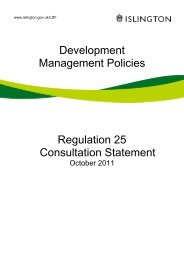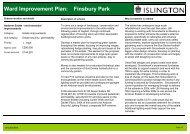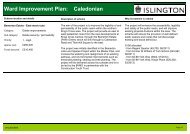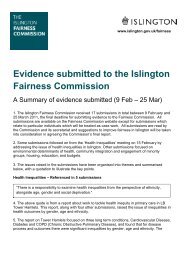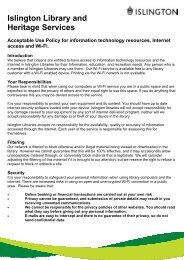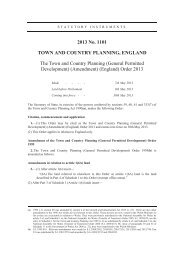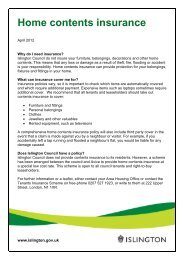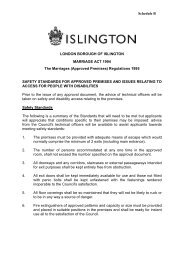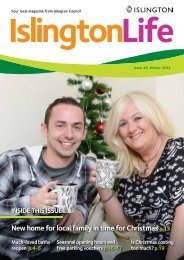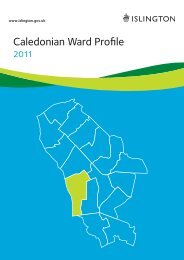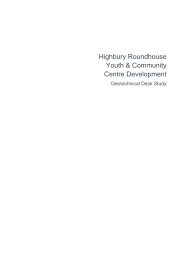Two Islingtons: Understanding the Problem - Islington Council
Two Islingtons: Understanding the Problem - Islington Council
Two Islingtons: Understanding the Problem - Islington Council
Create successful ePaper yourself
Turn your PDF publications into a flip-book with our unique Google optimized e-Paper software.
www.islington.gov.uk/fairness<br />
<strong>Two</strong> <strong><strong>Islington</strong>s</strong>: <strong>Understanding</strong> <strong>the</strong><br />
<strong>Problem</strong><br />
Review of Delivery and Action<br />
1. Introduction<br />
1.1. This paper summarises some of <strong>the</strong> key actions in <strong>Islington</strong>, across <strong>the</strong> <strong>Council</strong> and <strong>the</strong><br />
wider strategic partnership, to address fairness and equality. The paper is intended to<br />
assist <strong>the</strong> Commissioners in understanding <strong>the</strong> range and flavour of <strong>the</strong> actions that are<br />
currently being delivered in <strong>Islington</strong> to tackle equality and fairness from a number of<br />
different perspectives. In many ways <strong>the</strong> impact of <strong>the</strong>se actions being taken will be<br />
cumulative, reinforcing and have positive spill over affects for a range of outcomes that we<br />
want to achieve in <strong>Islington</strong>. For example, action to tackle deprivation can have positive<br />
impacts on housing inequalities, which can have positive impacts on health inequalities<br />
and so on.<br />
1.2. Because of <strong>the</strong> linked nature of <strong>the</strong> actions taken to tackle fairness and inequality it is very<br />
complicated to measure <strong>the</strong> totality of <strong>the</strong> impact an individual activity may have. This<br />
paper is not intended to assess <strong>the</strong> value for money of individual actions and <strong>the</strong>re is no<br />
assessment of <strong>the</strong> relative merits or contribution of different types of interventions, so in<br />
fact <strong>the</strong>re may well be better ways drive up fairness and equality at less cost. However an<br />
attempt has been made to assess <strong>the</strong> impact of certain activities as far as possible. It is<br />
not always possible to assess <strong>the</strong> affect of some kinds of activity ei<strong>the</strong>r because <strong>the</strong>y are<br />
fairly new initiatives or because <strong>the</strong> affect of <strong>the</strong> activity will only be measurable over time.<br />
For example identifying statistical trends in mortality rates from cardiovascular diseases is<br />
only possible over a period of years, however it is possible to identify <strong>the</strong> impact of<br />
activities to reduce smoking cession which can indicate <strong>the</strong> likelihood of reducing death<br />
from cardiovascular disease as smoking is a key risk factor.<br />
1.3. To help guide <strong>the</strong> Commission this paper only focuses on a limited number of activities<br />
and it is not intended to be comprehensive. Instead it sets out <strong>the</strong> range and flavour of<br />
activities across fairness and equality issues. Fur<strong>the</strong>r detail about specific policies can be<br />
found in <strong>the</strong> individual strategies, action plans and publications that underpin this paper.<br />
1
The main documents are summarised in <strong>the</strong> paper available on <strong>the</strong> Fairness Commission<br />
website what do people think and do about fairness in <strong>Islington</strong>. Key items are grouped<br />
2. Improving Aspirations and Education<br />
2.1. Pupil attainment levels differ significantly within <strong>the</strong> borough. Pupils from less prosperous<br />
backgrounds do not perform as well as those from wealthier backgrounds. Pupils eligible<br />
for free school meals perform below those not eligible. At GCSE White British pupils underperform<br />
against o<strong>the</strong>r ethnic groups and overall boys slightly outperform girls. Low<br />
attaining groups aged between 7 and 11, (Key stage 2 - KS2) include Turkish, Kurdish,<br />
Somali and Black Caribbean and at GCSE White, Somali, Mixed and Black Caribbean.<br />
The largest single NEET group is White (53%) with young White men being<br />
disproportionally represented. A high proportion of disabled people have no qualifications<br />
and disabled people, particularly those with learning difficulties, are disproportionately<br />
NEET.<br />
2.2. However, year on year exam results are improving. Additionally <strong>the</strong> gap between <strong>Islington</strong><br />
school students on free school meals and <strong>the</strong>ir peers at GCSE is now <strong>the</strong> lowest in<br />
England; while attainment of Black students is now equal to or above (in <strong>the</strong> case of those<br />
of African origin) this group nationally. The gap for White students is also narrowing and<br />
<strong>Islington</strong> students with English as an additional language now attain at <strong>the</strong> same level as<br />
this group nationally.<br />
2.3. The 2009 GCSE results showed that boys’ attainment, especially attainment by Black boys<br />
continues to improve sharply, and <strong>the</strong>re was a 7% rise in White British attainment. A<br />
renewed focus is needed on girls in all ethnic groups, as apart from Turkish children all<br />
ethnic group girls performed below boys of <strong>the</strong> same background and Turkish and<br />
Bangladeshi progress may be stalling after major gains in recent years.<br />
2.4. The Centre for Excellence and Outcomes in Children’s and Young People’s Services<br />
(C4EO) highlights <strong>the</strong> wealth of research showing that high quality early learning has a<br />
major and lasting positive impact on all children, but especially poor children. An effective<br />
focus on language and literacy development in <strong>the</strong> early years, particularly for children<br />
from disadvantaged backgrounds and those with English as an additional language, is a<br />
particularly effective strategy in narrowing <strong>the</strong> gap.<br />
2.5. The Narrowing <strong>the</strong> Gap programme which is supported through <strong>the</strong> Local Area<br />
Agreement (LAA) is focussing on specific ethnic groups at both 7-11yrs (KS2) and at 14-<br />
16yrs (KS4) and <strong>the</strong>se efforts are having an impact, particularly for Black and Mixed<br />
Heritage boys. In addition, targeted work of identifying improvements in curriculum<br />
delivery in some schools in specific subject areas is also starting to have an impact. The<br />
programme has a number of activities and projects that sit within it, for example, schools<br />
are encouraged to effectively use performance data available to <strong>the</strong>m so that specific<br />
issues in relation to that particular school or class are picked up and addressed. The idea<br />
is that <strong>the</strong> gaps are found, strategies put in place, monitored, and <strong>the</strong>n success celebrated.<br />
The issue will depend on <strong>the</strong> school and class and <strong>the</strong> gap could be across any equality<br />
group. The 1-1 tuition project targets students who have fallen behind, or who are at risk of<br />
falling behind, and is targeted at where <strong>the</strong> need is ra<strong>the</strong>r than a particular equality group.<br />
10 hours of individual 1-1 tuition is given and monitored to help bring <strong>the</strong> child up to level<br />
with his or her peers.<br />
2
2.6. However, recently released (provisional 2010) KS2 attainment data shows that <strong>the</strong><br />
percentage of pupils achieving level 4 or above in Maths and English has remained at<br />
similar levels to <strong>the</strong> previous two years, at around 70%. This is significantly below <strong>the</strong><br />
target of 77% and below <strong>the</strong> England average of 74%. Additionally <strong>Islington</strong> girls<br />
significantly out perform boys achieving 75% attainment against 68%.<br />
2.7. These results are currently not available by ethnic breakdown for 2010, however 2009<br />
results shows that overall progress of BME pupils at KS2 matches that of White British<br />
pupils at level 4 and above with a strong improvement in Maths for Turkish and Black girls,<br />
and in English for Black Caribbean girls. Progress at level 5 in Maths has been sustained<br />
for Turkish and Bangladeshi pupils. However <strong>the</strong> English gap at level 5 is increasing for all<br />
BME groups when compared to White British Pupils.<br />
2.8. Overall KS4 attainment rose by 6% in 2009 but it remains significantly lower than <strong>the</strong><br />
performance of our comparators. Performance also rose for <strong>the</strong> White and Mixed ethnic<br />
groups but again attainment of <strong>the</strong>se groups is much lower than <strong>the</strong> national average.<br />
Improving outcomes at KS4 remains a key priority, both to continue to narrow <strong>the</strong> gap<br />
between <strong>Islington</strong> performance and national performance and to continue to ensure that no<br />
schools are below <strong>the</strong> 30% threshold or within <strong>the</strong> 5% of that threshold.<br />
2.9. Outcomes for <strong>the</strong> lowest achieving 20% of children at <strong>the</strong> end of <strong>the</strong> Early Years<br />
Foundation Stage (reception class) have improved year on year since 2006. In 2010, for<br />
<strong>the</strong> first time, rates of improvement have been faster for <strong>the</strong> bottom 20% than for <strong>the</strong> rest<br />
and <strong>the</strong> gap, (expressed as a percentage between <strong>the</strong> median score and mean score of<br />
<strong>the</strong> lowest 20%), has decreased from 40% in 2007 to 34.8% in 2010, achieving <strong>the</strong><br />
equalities target for <strong>the</strong> year.<br />
2.10. By 19 years only 36.2% of young people who went to <strong>Islington</strong> schools had attained a<br />
Level 3 qualification (2 A Levels at grade A-E or equivalent) and only 63.1% had achieved<br />
a level 2 qualification (5 GCSEs at A*-C, or equivalent), at <strong>the</strong> end of <strong>the</strong> 2008/09<br />
academic year. The level 2 rate is <strong>the</strong> lowest level in London (and <strong>the</strong> second lowest in <strong>the</strong><br />
country), whilst <strong>the</strong> level 3 rate is <strong>the</strong> second lowest in London. These figures mean that<br />
too few young people can access good jobs or higher education.<br />
2.11. The <strong>Council</strong>s new 14-19 strategy sets out a robust action plan to address this low<br />
attainment. This includes actions to ensure schools take more responsibility for <strong>the</strong><br />
progression pathways <strong>the</strong>ir students take, steering students during <strong>the</strong> later stages of<br />
education to <strong>the</strong> higher quality provision post 16, ensuring that no young people fall<br />
through <strong>the</strong> net as well as a broad range of provision post 16 for all students, no matter<br />
what <strong>the</strong>ir ability.<br />
2.12. Childrens Centres provide a means to address <strong>the</strong> significant equalities gap that can<br />
open up in children’s well being and development by <strong>the</strong> time <strong>the</strong>y reach <strong>the</strong> age of 3. It<br />
has been shown on a national level that boosting <strong>the</strong> home learning environment at <strong>the</strong><br />
earliest stage (by providing culturally sensitive outreach and family support) and supporting<br />
<strong>the</strong> transitions from home to early learning provision and <strong>the</strong>n to mainstream school to be<br />
particularly effective in addressing <strong>the</strong>se inequalities.<br />
2.13. <strong>Islington</strong> has a borough wide network of 16 Children’s Centres. These centres provide a<br />
universal non-stigmatising environment in which to target children from when <strong>the</strong>y are born<br />
to when <strong>the</strong>y are admitted to school with a range of support services from personalized<br />
3
care, education, health and family support. Bilingual family support workers have targeted<br />
Somali, Bangladeshi and Turkish communities and have made a measurable difference to<br />
widening access to children’s centre services. <strong>Islington</strong>’s admission’s policy ensures that<br />
30% of care and education places in every children’s centre are allocated to vulnerable<br />
children who are in need and who have been referred to <strong>the</strong> centre by social workers and<br />
health professionals.<br />
2.14. The NEET’s engagement programme is on track to deliver most of its targets for<br />
contacting and engaging young people on programmes. However, <strong>the</strong> proportion<br />
achieving accreditation and entering EET is slightly lower than targets would indicate<br />
should be <strong>the</strong> case. Agreement was reached with City and <strong>Islington</strong> College to offer a<br />
guarantee to all those 16 and 17 year olds who may have not yet taken up EET or who<br />
needed to reconsider <strong>the</strong>ir pathway. This ‘January Guarantee’ provides additional access<br />
to courses starting from January 2010. The official NEET’s count (Qtr3 2009/10) was 7.8%<br />
which is <strong>the</strong> same as <strong>the</strong> previous year and above <strong>the</strong> central London average of 6.2%.<br />
2.15. Considerable progress has been made towards positive change in comparison to our<br />
neighbours over <strong>the</strong> last 5 years. The level of NEETs has reduced by nearly 10% from<br />
October 2004 which is faster than <strong>the</strong> London average of 6%. Progress has also been<br />
made towards reducing <strong>the</strong> number of people we don’t have information about. We are<br />
continuing to stabilise this and as at September 2009 this stood at 4.2%. This performance<br />
is as a result of a number of on going actions, for example, targeting of <strong>the</strong> most at risk<br />
groups through data analysis, implementation of processes and procedures for tracking of<br />
young people within certain timescales as part of every personal adviser’s work and <strong>the</strong><br />
Career Start project which provides employment and work experience opportunities for<br />
looked after young people and care leavers.<br />
2.16. We have a good understanding of <strong>the</strong> inequalities that exist in educational attainment as<br />
<strong>the</strong>re is a wealth of data collected and analysed on a regular basis. Addressing inequalities<br />
in achievement is one of <strong>the</strong> main challenges facing <strong>the</strong> <strong>Council</strong> and its partners. Despite<br />
year on year improvements overall in attainment results we continue to under-perform in<br />
comparison to <strong>the</strong> national achievements and inequalities continue to exist between<br />
different equality groups within <strong>the</strong> borough, particularly between different ethnic groups<br />
and <strong>the</strong> genders. We know that 95% of our NEETs are from families on out of work<br />
benefits highlighting <strong>the</strong> issue of intergenerational worklessness and that <strong>the</strong>re is also a<br />
high proportion of White children who are NEETs. The Children and Young Peoples plan<br />
details how <strong>the</strong>se inequalities are to be addressed. The Children’s Services Ofsted self<br />
assessment document (July 2010) provides <strong>the</strong> needs assessment for <strong>the</strong> plan which will<br />
be completed by April 2011.<br />
3. Family Based Interventions & Direct Support<br />
3.1. <strong>Islington</strong> <strong>Council</strong> has launched a new volunteering project in partnership with national<br />
charity Community Service Volunteers (CVS) called Think Family. The project is a<br />
volunteer scheme aimed at supporting vulnerable families in which a parent or carer has<br />
mental health problems and where <strong>the</strong>re are children under <strong>the</strong> age of nineteen.<br />
Volunteers make regular visits to families and offer non-judgmental practical and emotional<br />
support to help <strong>the</strong>m improve <strong>the</strong>ir family life. This could include a range of tasks including<br />
helping socially isolated families access local services, enabling children to take part in<br />
activities, offering support with parenting skills and practical household tasks and being a<br />
role model to children and parents who might not have many in <strong>the</strong>ir lives.<br />
4
3.2. This project is a fairly new initiative and <strong>the</strong>refore <strong>the</strong> impact upon vulnerable families is yet<br />
to be assessed. However, so far through <strong>the</strong> Think Family scheme 61 ‘whole families’ and<br />
23 young carer ‘whole families’ have received direct support. The Whole Family<br />
Assessments (WFA) assess families with complex needs related to parental mental illness.<br />
3.3. The Packington Families Project is a partnership between Children’s Services and<br />
Housing which tailors support and advice to families on a range of issues including money<br />
advice, finding work and training, parenting, housing, health, school and activities for<br />
children and young people. The involvement of Housing means <strong>the</strong> project identifies and<br />
engages families early on ra<strong>the</strong>r than when a crisis arises and <strong>the</strong> “think family” approach<br />
ensures <strong>the</strong> whole family gets <strong>the</strong> support it needs regardless of which agency <strong>the</strong>y<br />
contact first. The project focuses on <strong>the</strong> Packington Estate and is based on resident<br />
consultation, local data and agency knowledge that showed that as well as being in <strong>the</strong> 5%<br />
most deprived areas of <strong>the</strong> UK, a larger number of families had additional needs including<br />
poor school attendance and high dependence on benefits. Families could be identified<br />
through one of <strong>the</strong> project’s 17 partners or could self-refer through outreach, community<br />
events and a weekly drop-in.<br />
3.4. The approach is based on a model of integrated working in use across <strong>the</strong> children’s<br />
workforce, which uses <strong>the</strong> Common Assessment Form – CAF (or in this case a family<br />
CAF); this includes strong information sharing arrangements and a common language<br />
across practitioners to support <strong>the</strong> families and a lead practitioner to hold <strong>the</strong> ring in a team<br />
around <strong>the</strong> family. Integrated working is fundamental to how we undertake earlier<br />
intervention with children, young people and <strong>the</strong>ir families. Over 800 practitioners have<br />
been trained since <strong>the</strong> integrated working programme started in 2007, most of <strong>the</strong>m in<br />
universal settings<br />
3.5. In total <strong>the</strong> project has engaged with 26 families since it launched in February 2009,<br />
exceeding <strong>the</strong> project target of 20 families. Outcomes for <strong>the</strong> families to date include:<br />
• Income maximisation; around £5000 in grants and one-off payments have been secured,<br />
over £200 of debts have been cancelled and over £600 per week has been secured in<br />
additional benefits for <strong>the</strong> families,<br />
• School absenteeism of children in <strong>the</strong>se families has reduced,<br />
• Anti social behaviour issues have been successfully addressed for six families who were<br />
identified as being involved with youth-related ASB. There have been improvements for all<br />
families, including fewer or no reports of ASB, engagement of parents with <strong>the</strong> process<br />
and providing support to prevent Notices Seeking Permission going to court proceedings.<br />
3.6. The Free School Meals pilot has taken place in 6 primary schools, providing meals to all 3<br />
to 11 year olds. Take-up of school meals within <strong>the</strong>se schools increased from 62% to 82%.<br />
The project will now roll out to all primary and nursery schools. This should benefit parents<br />
on low incomes earning above <strong>the</strong> threshold for national criteria. The impact of this<br />
initiative is yet to be assessed but it is anticipated that <strong>the</strong> long term outcomes will include<br />
an increase to family incomes, which will impact significantly on those families who are sat<br />
on <strong>the</strong> poverty margins, as well as behavioural improvements at school and long term<br />
health benefits for <strong>the</strong> children.<br />
3.7. The Rocket Science report ‘Consumer Debt in <strong>Islington</strong>’ (Jan 2010) sets out <strong>the</strong> picture<br />
of consumer debt across <strong>the</strong> borough. Postcodes were analysed against 5 consumer debt<br />
5
3.8. The <strong>Council</strong> and several partner organisations have formed a coalition to tackle debt in<br />
<strong>Islington</strong>. The Debt Coalition aims to help <strong>Islington</strong> residents with debt problems as part<br />
of <strong>the</strong> boarder anti-poverty strategy. The main objective of this initiative is to raise <strong>the</strong><br />
importance of debt prevention and recovery, putting <strong>the</strong> importance of tackling debt at <strong>the</strong><br />
heart of <strong>the</strong> local anti-poverty strategy. The Debt coalition projects come under <strong>the</strong> <strong>the</strong>me<br />
of prevention, mitigation, corporate good practice, communication and evaluation.<br />
Examples of projects include linking up with o<strong>the</strong>r organisations working on financial<br />
inclusion, financial capability and o<strong>the</strong>r areas as well as training frontline staff to provide<br />
high quality information to residents. The Debt coalition strategy was signed off in February<br />
2010 and <strong>the</strong>refore <strong>the</strong> projects are still in <strong>the</strong> early stages of development and<br />
implementation.<br />
3.9. Research from two pilot projects in illegal money lending shows that it reinforces financial<br />
and social exclusion and exacerbates anti-social behaviour. Evidence suggests that<br />
victims of illegal lending are likely to be female, lone parents or disabled. Over half of <strong>the</strong><br />
victims will have defaulted with o<strong>the</strong>r legal lenders and have exhausted all o<strong>the</strong>r credit<br />
lines. The Financial Inclusion Team work with victims to identify <strong>the</strong> issues that have led<br />
<strong>the</strong>m to resort to loan sharks and support <strong>the</strong>m in accessing appropriate support and<br />
advice within <strong>the</strong> community. Specific work has included <strong>the</strong> distribution of posters and<br />
leaflets across <strong>the</strong> borough, including information in money advice awareness sessions<br />
given to local advice agencies and community groups, a presentation at <strong>Islington</strong> Housing<br />
Action Group and advertising <strong>the</strong> service through this years council tax bill.<br />
3.10. The <strong>Council</strong> funds free advice services for residents delivered by <strong>the</strong> borough’s specialist<br />
independent advice agencies (<strong>Islington</strong> Law Centre, <strong>Islington</strong> People’s Rights and <strong>Islington</strong><br />
CAB). These allow residents on low incomes to get advice and representation on a range<br />
of issues including, housing, welfare benefits, debt, employment and immigration.<br />
Combined, <strong>the</strong> three agencies handle over 80,000 enquiries each year and provide<br />
detailed casework to around 13,500 residents. Additionally as part of <strong>the</strong> <strong>Council</strong>’s<br />
recession support, £25,000 was given to develop <strong>the</strong> capacity of smaller voluntary and<br />
community organisations in <strong>the</strong> borough to provide advice to <strong>the</strong>ir users and effectively<br />
diagnose and refer to appropriate specialist advice services where necessary. 310 training<br />
places were attended by staff and volunteers from 67 different local voluntary<br />
organisations supporting a range of residents (in particular, LBGT, <strong>the</strong> disabled, refugees<br />
and asylum seekers, faith groups and older and younger people).<br />
3.11. A range of o<strong>the</strong>r activities and projects have been implemented contributing to assisting<br />
residents out of debt, <strong>the</strong>se include:<br />
6
• During 2009/10, <strong>the</strong> <strong>Islington</strong> Credit Union was able to increase its membership by 75%<br />
and provided 549 individual loans. Assisted through funding from <strong>the</strong> <strong>Council</strong> <strong>the</strong> union<br />
helps residents who find it difficult to get credit from standard lenders, diverting <strong>the</strong>m away<br />
from sub-prime borrowers who charge exorbitant rates of interest.<br />
• Benefit checks to all working households with children where income is below <strong>the</strong> 60%<br />
median and all those with earned income,<br />
• A Credit Crunch Hotline and Credit Crunch Roadshows offering advice and guidance<br />
to residents,<br />
• The Springboard project which is aimed at assisting residents with a wide range of<br />
disabilities including physical, mental, visual, hearing and learning difficulties, with over a<br />
third of clients reporting multiple impairments. The project has set up a debt advice service<br />
in partnership with <strong>the</strong> Citizens Advice Bureau and monthly financial advice sessions<br />
provided by <strong>the</strong> Financial Services Authority. Partnerships with Age Concern and Elfrida<br />
amongst o<strong>the</strong>rs have enabled <strong>the</strong> project to ensure it gives advice on as wide a range of<br />
subjects as possible to this vulnerable section of <strong>the</strong> community.<br />
3.12. The ISP commissioned ‘Energy Doctor in <strong>the</strong> Home’ project has a target to visit and<br />
work with 600 residents a year. All Energy Doctor work and events are targeted towards<br />
those wards and sections of <strong>the</strong> community most likely to be in fuel poverty such as <strong>the</strong><br />
elderly and people with disabilities. £4.3M has been secured for 2009-11 from <strong>the</strong> Homes<br />
and Communities Agency to insulate 6000 hard to treat cavity-walled Homes for <strong>Islington</strong><br />
properties, reducing bills for many tenants and also helping with CO2 emissions. The<br />
number of households where work has been done to improve energy efficiency stood at<br />
4106 for quarter 2010/11. This new indicator counts all <strong>the</strong> achievements arising from a<br />
basket of schemes and programmes including ‘safe and warm’ grants for owner/occupiers,<br />
HFI cavity wall insulation and Energy Doctor in <strong>the</strong> Home. The Energy Doctor in <strong>the</strong> Home<br />
service in particular is highly popular with excellent customer feedback. This work should<br />
directly benefit those households where work has been carried out, saving money spent on<br />
fuel for <strong>the</strong> home.<br />
4. Access to Work and Employment<br />
4.1. Employment and worklessness are significant issues for <strong>Islington</strong> residents. We know that<br />
fewer women than men are economically active, with women in <strong>Islington</strong> lower paid than<br />
men. In terms of ethnicity 36% of Pakistani and Bangladeshi women have no<br />
qualifications, and first generation Pakistani men are almost twice as likely as <strong>the</strong>ir White<br />
comparators to have no qualifications. Unemployment for Bangladeshi men is twice that<br />
for White men and Black Caribbean men are most likely to be unemployed. A high<br />
proportion of disabled people have no qualifications and just 49% of disabled people are<br />
employed (compared with 66.3% non-disabled). In <strong>Islington</strong>, 38,000 people, equivalent to<br />
about 26.% of <strong>the</strong> working age population, are economically inactive. This is slightly<br />
higher than <strong>the</strong> rest of London where 25% of <strong>the</strong> working age population is economically<br />
inactive and <strong>the</strong> rest of Britain where 24% is. Ward data shows that <strong>the</strong> highest<br />
unemployment is in Finsbury Park and Hillrise and <strong>the</strong>re are 10 wards in <strong>Islington</strong> 1.5%+<br />
above <strong>the</strong> national average. However recently released 2009 skills data shows an<br />
improvement in skill levels across <strong>the</strong> borough within <strong>the</strong> % of working age population with<br />
a level 2,3 or 4 qualification all increasing from 2008 with <strong>the</strong> biggest increase in those with<br />
a level 3 qualification improving from around 60% in 2008 to 65 % in 2009. Additionally <strong>the</strong><br />
level of local people with no qualifications has dropped below <strong>the</strong> London and GB<br />
averages for <strong>the</strong> first time since <strong>the</strong>se records have been published (2004), dropping 3%<br />
points to 11%, 1% point below <strong>the</strong> new London figure.<br />
7
4.2. In terms of poverty around 40% of 0-15 year olds are living in families on means tested<br />
workless benefits, which represents 14,055 of a total of 35,453 <strong>Islington</strong> children aged 0-<br />
15. There are over 16,500 children and young people aged 0-19 living in workless<br />
families. Older people from BME groups are more likely to live in households below<br />
national income level (31% compared with general figure of 20%) and are far more likely to<br />
experience problems claiming benefits than White British (only 11% BME have NOT had<br />
problems compared with 42% White). In <strong>Islington</strong>, <strong>the</strong> highest rate of people never having<br />
worked is amongst <strong>the</strong> Bangladeshi community around 29%. This rate is proportionally<br />
nine times that of White British residents and significantly higher than <strong>the</strong> <strong>Islington</strong> average<br />
with is around 6%. A range of activities and actions has been in place to mitigate <strong>the</strong><br />
impact of <strong>the</strong> recession upon residents including<br />
4.3. <strong>Islington</strong> Working, <strong>Islington</strong> Working for Parents and Adult and Community Learning<br />
provide <strong>Islington</strong>’s main support services to helping local people become skilled,<br />
employable and confident about finding work. The services work closely toge<strong>the</strong>r to<br />
ensure that <strong>the</strong>re is a progression route towards getting and keeping a job and at <strong>the</strong> same<br />
time offers a recruitment service to employers.<br />
4.4. The <strong>Islington</strong> Working package of training and employment support assists a wide range<br />
of <strong>Islington</strong> clients, offering paid work and work experience placements to <strong>Islington</strong><br />
residents. The worklessness programmes are targeted to address <strong>the</strong> needs of<br />
disadvantaged communities with BME clients making up 68% or over of <strong>the</strong> total of those<br />
receiving employment support or starting a paid job. Disabled clients make up 15% of<br />
those receiving employment support. Activities have included <strong>Islington</strong> Working link officers<br />
working with ‘Connect’ to roll out neighbourhood outreach and referral door knocking in<br />
Finsbury Park while community ‘employment coaches’ are also working with out-reach<br />
health workers and health centres. There are eight specialist parent advisers to delivery<br />
new services to support lone parents with children under 7 and o<strong>the</strong>r parents with children<br />
under 4 to help <strong>the</strong>m work towards employability and to start planning towards<br />
employment. The staff work very closely with benefits advisers, health workers and<br />
children’s centre staff to ensure that parents receive <strong>the</strong>ir maximum benefits entitlement<br />
and ‘better off’ calculations before entering work. To date <strong>the</strong> team have supported 627<br />
parents and 141 have been referred for training.<br />
4.5. During 2009/10 <strong>Islington</strong> engaged with 2,000 clients who were 44% female, 10% disabled<br />
and 67% BME of which 50% had been out of work for 6 months or more. Over <strong>the</strong> year,<br />
689 clients were successful in securing ei<strong>the</strong>r paid employment or a substantial work<br />
experience placement. 539 clients secured paid employment of 16 hours a week or more<br />
through <strong>Islington</strong> Working, including 167 through <strong>the</strong> Future Jobs Fund project; a fur<strong>the</strong>r 20<br />
secured paid employment for less than 16 hours a week and 130 secured a work<br />
experience placement. During 2010/11 to date a fur<strong>the</strong>r 579 clients are being supported<br />
including 142 parents with 102 gaining work. The service to deliver on this project is<br />
through <strong>Islington</strong> Working for Parents.<br />
4.6. The Adult and Community Learning (ACL) programme helps residents in <strong>the</strong><br />
development of functional and employability skills, including language skills, and referral to<br />
projects that can assist with vocational training, job hunting skills and introductions to<br />
employers with vacancies. The main educational partner is City and <strong>Islington</strong> College<br />
(CIC). ACL and CIC are working toge<strong>the</strong>r to deliver a new ESOL, literacy and numeracy<br />
project funded through <strong>the</strong> <strong>Islington</strong> Strategic Partnership’s Social and Economic Well-<br />
8
Being Board (SEW). ACL also works in partnership with voluntary organisations and o<strong>the</strong>r<br />
statutory services. ACL’s mission is to improve <strong>the</strong> quality of life and life chances for<br />
<strong>Islington</strong>’s most disadvantaged and vulnerable adults and <strong>the</strong>ir families, many of whom are<br />
fur<strong>the</strong>st away from <strong>the</strong> labour market. Most of <strong>the</strong>se residents have been disengaged from<br />
education and would not access provision in mainstream educational settings. In 2009-10<br />
ACL courses were attended by 2,182 learners, with a total of 5,123 enrolments across <strong>the</strong><br />
year. Additionally <strong>the</strong> number of <strong>Islington</strong> residents achieving Pre Entry, Entry Level, Level<br />
1 and Level 2 skills and qualifications totalled 1,502 throughout 2009/10.<br />
4.7. Fur<strong>the</strong>r employment and training opportunities are gained through S106 planning<br />
agreements and are used to secure construction training placements for local residents, as<br />
well as a range of opportunities for training in <strong>the</strong> end use of <strong>the</strong> employment<br />
developments. Developers have also signed up to <strong>the</strong> <strong>Council</strong>'s local procurement<br />
programme through which £7m of contracts have been awarded to <strong>Islington</strong> and Camden<br />
firms in <strong>the</strong> first year of <strong>the</strong> current programme. Local companies employ a higher<br />
proportion of <strong>Islington</strong> residents compared with outside firms and so this helps to create<br />
fur<strong>the</strong>r local employment opportunities.<br />
4.8. The Child Poverty Innovation Pilot aims to help those children living in poverty within <strong>the</strong><br />
borough. There are 3 arms to child poverty: development and analysis (using data to<br />
effectively target those families and children in poverty with services), delivery (<strong>the</strong><br />
principle underlying this approach is early intervention) and sustainability (training <strong>the</strong> 3rd<br />
sector).<br />
4.9. The project has also been imbedded via <strong>the</strong> service planning process which has so far<br />
secured over 70 commitments across <strong>the</strong> council to improve child poverty. These range<br />
from commitments to reviewing strategies to ensure that <strong>the</strong> needs of low income families<br />
are considered, through to a commitment to train frontline staff to be able to provide<br />
employment advice when <strong>the</strong>y come into contact with people. Assessment of progress will<br />
be made at <strong>the</strong> end of <strong>the</strong> financial year to measure <strong>the</strong> impact of <strong>the</strong> commitments made.<br />
Availability of up to date data on child poverty within <strong>the</strong> borough, in comparison to o<strong>the</strong>r<br />
authorities regionally and nationally, is limited and <strong>the</strong>refore <strong>the</strong> high-level impact of <strong>the</strong><br />
pilot in terms of data analysis won’t be available for some time.<br />
4.10. In 2007 Age Concern <strong>Islington</strong> undertook research with <strong>the</strong> <strong>Islington</strong> benefits team to<br />
identify <strong>the</strong> barriers experienced by older people from BME groups when trying to claim<br />
benefits <strong>the</strong>y are entitled to. The aim of <strong>the</strong> research was to develop solutions to overcome<br />
<strong>the</strong>se barriers, for <strong>the</strong> benefit of all older people. The final report ‘I never beg me bread<br />
yet’ recommended a number of actions. Some of <strong>the</strong> projects implemented as a result<br />
included creating mechanisms for word of mouth referrals, training for staff, and<br />
improvements to communication material to target older people. As at March 2010 <strong>the</strong><br />
Joint Visiting Team and <strong>Islington</strong> Benefits Team had increased income maximisation for all<br />
older people by £3 million. Since 2007 <strong>the</strong> average annual value generated by take up of<br />
key benefits by people aged 60+ increased by £303 to £2,632, an increase of around 6%.<br />
4.11. As with educational attainment inequalities, inequalities experienced by residents of <strong>the</strong><br />
borough in relation to access to work and employment is a significant challenge. It is<br />
difficult to assess <strong>the</strong> impact of many of <strong>the</strong> projects and activities in place to tackle<br />
worklessness when nationally <strong>the</strong> recession has had a significant impact on employment<br />
and income. However, we do know that <strong>Islington</strong> is narrowing <strong>the</strong> gap with <strong>the</strong> rest of<br />
England in relation to <strong>the</strong> National Indicators on reducing child poverty and reducing <strong>the</strong><br />
9
5. Tackling Housing Inequalities<br />
5.1. There are significant inequalities between residents in regards to access to and <strong>the</strong><br />
provision of affordable housing and decent housing within <strong>the</strong> borough. More women than<br />
men live in non-decent / social housing. Older disabled people and those suffering from<br />
long-term physical & mental health problems are more likely to have a lack of housing or<br />
inadequate / poor quality housing and 40% of children live in overcrowded unfit housing.<br />
Housing inequalities are significantly impacted upon by <strong>the</strong> availability of affordable<br />
housing in <strong>the</strong> borough and severe over-crowding issues.<br />
5.2. <strong>Islington</strong> has a high level of social housing, and a high level of inequality and <strong>the</strong>se two<br />
facts are almost certainly correlated. The John Hills report ‘Ends and means: <strong>the</strong> future<br />
roles of social housing in England’ (2007) states that tenants are more likely to have low<br />
incomes and not be in employment compared to those in o<strong>the</strong>r tenures. Nationally 70% of<br />
social tenants have incomes within <strong>the</strong> poorest two fifths of overall income distribution and<br />
<strong>the</strong> proportion of social tenant households in paid employment fell from 47% to 32%<br />
between 1981 and 2006. Tenants also have high rates of disabilities and are more likely<br />
than o<strong>the</strong>rs to be lone parents, single people and be over 60. Additionally, more than a<br />
quarter of BME household are social tenants.<br />
5.3. Reducing overcrowding: Overcrowding officers have been dealing with <strong>the</strong> housing<br />
queries raised by <strong>the</strong> door knocking initiatives in <strong>the</strong> borough such as ‘Help on your<br />
doorstep’, ‘<strong>the</strong> Canonbury Project’ and ‘EC1 New Deal’. Six tenants have taken up <strong>the</strong><br />
‘Time Out’ scheme and moved into private sector homes suitable for <strong>the</strong>ir needs. An<br />
additional 15 families have been helped with space saving furniture to mitigate <strong>the</strong> affects<br />
of living in an overcrowded home while <strong>the</strong>y wait for a housing transfer. The annual target<br />
to assist 160 severely overcrowded households has been met with 278 households<br />
assisted in 2009-10. Of those applicants within <strong>the</strong> third quarter of 2009-10 <strong>the</strong> majority<br />
came from <strong>the</strong> under 16 age group and from White British or Black African households.<br />
5.4. Homelessness: A number of projects are in place to tackle homelessness within <strong>the</strong><br />
borough. Work has been undertaken to address <strong>the</strong> findings of <strong>the</strong> Black Homelessness<br />
study of December 2007. Workshops were held with <strong>the</strong> voluntary sector to see how <strong>the</strong><br />
findings could be taken forward and as a result a number of internal processes and<br />
procedures were revised such as establishing an email alert system to advise on changes<br />
in policies and legislation with regard to housing and homelessness issues. Additionally<br />
<strong>the</strong> Homelessness Forum progresses issues within <strong>the</strong> borough. During April-Jan 2009/10<br />
569 residents were prevented from becoming homeless and 53 unsuccessfully prevented.<br />
Since 2006-07 <strong>the</strong> numbers of residents accepted as homeless and in priority need per<br />
10000 households has significantly decreased within <strong>the</strong> borough (from 2.0 to 0.7) and is<br />
now on a par with London, although higher than <strong>the</strong> England figure.<br />
5.5. The Home Shelter Sanctuary Scheme offers <strong>the</strong> victims of domestic violence <strong>the</strong> option<br />
of remaining in <strong>the</strong>ir home as an alternative to making an application for emergency<br />
housing assistance. The scheme is a partnership between <strong>the</strong> <strong>Council</strong>, <strong>the</strong> Police and<br />
Kier; who enable <strong>the</strong> victims of Domestic Violence <strong>the</strong> opportunity to remain in <strong>the</strong>ir home<br />
10
ut with extra security measures such as locks and fireproof letterboxes to make <strong>the</strong>m feel<br />
secure. The scheme is open to tenants, leaseholders or home owners.<br />
5.6. In <strong>the</strong> last financial year 54 households have been assisted who would o<strong>the</strong>rwise have<br />
been homeless and placed into temporary accommodation, many of <strong>the</strong>se households<br />
contain children who would have had <strong>the</strong>ir schooling disrupted by a move to new<br />
accommodation. The scheme has been running since 2005 during which time it won a<br />
national innovation award and has helped hundreds of families.<br />
5.7. Maximising <strong>the</strong> delivery of affordable housing is a key priority. The authority is using its<br />
planning powers to tackle <strong>the</strong> acute shortage of housing that can be accessed by local<br />
residents. Through <strong>the</strong> Core Strategy, <strong>the</strong> council's spatial plan for <strong>the</strong> next 15 years, <strong>the</strong><br />
<strong>Council</strong> has set a target of 50% of all new housing developments to be affordable. During<br />
2008/9, 492 affordable homes were provided in <strong>Islington</strong> (Annual Monitoring Report 2009),<br />
this is more than <strong>the</strong> amount of affordable housing built by <strong>the</strong> vast majority of London<br />
boroughs. The majority of <strong>the</strong>se 492 homes are social housing, and <strong>the</strong>y have been<br />
allocated to <strong>Islington</strong>'s residents who are in greatest need. A smaller proportion of <strong>the</strong><br />
above figure is 'intermediate' housing. These are normally 'part rent, part buy' properties,<br />
usually allocated to key workers and local residents who meet eligibility criteria.<br />
5.8. The <strong>Council</strong> requires a range of types of provision and financial contributions from<br />
developers through planning S106 agreements as a part of <strong>the</strong> planning process. This is<br />
<strong>the</strong> main route for affordable housing delivery in <strong>the</strong> borough. Contributions for enhancing<br />
and increasing <strong>the</strong> capacity of facilities and infrastructure have been secured to offset <strong>the</strong><br />
impacts of developments, but also with significant benefit for existing residents. In <strong>the</strong> last<br />
two financial years 160 local transport, open space, community, playspace and leisure<br />
schemes have been funded including improvements to open spaces and o<strong>the</strong>r facilities.<br />
Many of <strong>the</strong>se are located in and around <strong>the</strong> <strong>Council</strong>'s housing estates and are accessible<br />
to <strong>the</strong> borough's most deprived residents<br />
5.9. Green spaces are now seen as a determining factor in regeneration projects, projects that<br />
do not address <strong>the</strong> environment often produce places where people do not want to live and<br />
those that can will leave once able to do so, however this creates inequalities between<br />
residents who have access to good quality green spaces. In <strong>Islington</strong> greenspace on<br />
housing estate land has been brought up to <strong>the</strong> same grounds maintenance standard of<br />
parks. Green flags awarded for <strong>the</strong> quality of parks have been focused on <strong>the</strong> 10% most<br />
deprived super output areas in <strong>the</strong> borough, <strong>the</strong>refore reducing <strong>the</strong> disparities in <strong>the</strong> quality<br />
of greenspaces across <strong>the</strong> borough.<br />
5.10. Additionally a key objective in <strong>the</strong> Local Development Framework Core Strategy is to<br />
ensure that new developments and <strong>the</strong> spaces around it provide a high quality<br />
environment that is accessible to all residents, employees and visitors. To that end <strong>the</strong><br />
authority operates inclusive design and accessible housing policies, against which all<br />
planning applications are assessed. To enable developers to deliver on those policies<br />
supplementary Planning Documents on ‘Accessible Housing’ and ‘Inclusive Landscape<br />
Design’ have been produced. These documents were drawn up in liaison with <strong>the</strong> local<br />
disability organisation and establish a standard that is unique to <strong>Islington</strong>.<br />
11
6. Reducing Health Inequalities<br />
6.1. Health inequalities mirror o<strong>the</strong>r income and o<strong>the</strong>r inequalities in <strong>the</strong> borough. There is a<br />
high prevalence of smoking amongst certain groups including Bangladeshi, Irish, Turkish,<br />
Somali and Pakistani men. BME backgrounds are significantly over-represented in<br />
specialist mental health services, in particular Black African, Black Caribbean and Irish<br />
communities as well as a high level of mental health issues and disability amongst refuges<br />
& asylum seekers. Child obesity in <strong>Islington</strong> is worse than national average – 25% of<br />
children are obese and 40% are overweight by <strong>the</strong> age of 11-12 and children & young<br />
people in <strong>Islington</strong> are 36% more likely than counterparts in London / England to<br />
experience mental health problems.<br />
6.2. There is a national target to reduce health inequalities by 2010, as measured by infant<br />
mortality and life expectancy at birth. Life expectancy in <strong>Islington</strong> is lower than <strong>the</strong> national<br />
average. Men in <strong>Islington</strong> have <strong>the</strong> lowest life expectancy in London at around 75 years,<br />
and women have <strong>the</strong> fourth lowest life expectancy, at 81 years. Although life expectancy in<br />
<strong>Islington</strong> is increasing, <strong>the</strong> gap between <strong>Islington</strong> and <strong>the</strong> rest of London and England is<br />
widening, as life expectancy is increasing elsewhere at a faster rate.<br />
6.3. The diffuse nature of health inequalities in <strong>Islington</strong> presents challenges when designing<br />
interventions that target high risk groups, as well as interventions that address <strong>the</strong> health<br />
needs across <strong>the</strong> whole population. Recommendations from <strong>the</strong> recently published<br />
Marmot review and <strong>the</strong> Mayor of London health inequalities strategy recommend that all<br />
interventions must address <strong>the</strong> whole population across <strong>the</strong> social gradient. This means<br />
that small scale interventions targeting small numbers or groups are not effective to<br />
improve overall health status in <strong>Islington</strong> over <strong>the</strong> long term. This approach, to address<br />
health inequalities across <strong>the</strong> social gradient, requires universal action and interventions<br />
where <strong>the</strong> whole population have <strong>the</strong> opportunity to benefit as well as targeted<br />
interventions with particular high risk groups.<br />
6.4. A programme of work over <strong>the</strong> short, medium and long term is in place to tackle existing<br />
inequalities as identified in <strong>the</strong> <strong>Islington</strong> Health Inequalities Strategy, “Closing <strong>the</strong> Gap,<br />
Tackling Health Inequalities in <strong>Islington</strong>”. Short term actions to improve life expectancy<br />
focus on reducing early deaths across <strong>the</strong> borough. Diseases responsible for early<br />
deaths include cardiovascular disease (CVD), cancer, infant deaths, and seasonal excess<br />
deaths such as winter deaths. Projects and activities in place include <strong>the</strong> development of<br />
<strong>the</strong> Seasonal Health and Affordable Warmth Strategy which will target individuals at<br />
high risk of early death particularly winter deaths e.g. vulnerable elderly (particularly those<br />
living alone or in care homes), those in poverty and fuel poverty and those unable to adapt<br />
to adverse wea<strong>the</strong>r conditions – e.g. learning and physical disabilities.<br />
6.5. Medium term actions aim to improve lifestyle behaviours which contribute to poor health<br />
such as smoking, healthy eating, physical activity, alcohol and drug misuse, mental health,<br />
sexual health and teenage pregnancy. Progress on three of <strong>the</strong> lifestyle areas are<br />
identified in this paper; mental health, health eating and smoking cessation.<br />
6.6. Projects and activities in place include implementation of <strong>the</strong> <strong>Islington</strong> Mental Health<br />
Promotion Strategy with universal action to address stigma and discrimination and<br />
promote early identification of mental heath problems. Targeted actions address<br />
vulnerable communities and those in <strong>the</strong> criminal justice system, carers, and clients with<br />
existing mental health problems. Long term actions aim to address social determinants<br />
12
of health such as <strong>the</strong> economy and employment, housing, education, and community<br />
safety.<br />
6.7. The Healthy Schools Programme supports schools in ‘Healthier Living and Learning’ –<br />
providing opportunities for enhancing emotional and physical health to improve long-term<br />
health, reduce health inequalities, increase social inclusion and raise achievement for all.<br />
In <strong>Islington</strong>, <strong>the</strong> healthy schools programme acts as <strong>the</strong> key project to influence and<br />
support schools’ work to address <strong>Islington</strong>’s health priorities.<br />
6.8. At <strong>the</strong> start of <strong>the</strong> year ten <strong>Islington</strong> schools signed up for <strong>the</strong> enhancement model for<br />
healthy schools. A co-ordinator has been appointed for <strong>the</strong> ‘Family Kitchen Programme’,<br />
and <strong>the</strong>y have recruited 15 schools and children’s centres to date to host <strong>the</strong> programme.<br />
Work in 2 targeted schools has begun to increase <strong>the</strong> work in addressing healthy eating<br />
and physical activity, developing <strong>the</strong>ir programmes from a base-line of practice. The new<br />
primary PSHE Education and Citizenship scheme of work has been promoted to all<br />
schools. There are now 59 schools within <strong>the</strong> borough with national healthy school status.<br />
6.9. Obesity in primary school year 6 children has decreased since 2006/07 from 23.6% to<br />
21.4% in 2009. Although <strong>the</strong> rate is below that of our statistical neighbours and similar to<br />
London, it is above <strong>the</strong> England average and our long term goal of significantly reducing<br />
childhood obesity rates and <strong>the</strong>refore remains a challenge. Worryingly obesity in reception<br />
classes has risen from 10.6% in 2008 to 12.6% in 2009. In order to address this <strong>Islington</strong><br />
has also developed an innovative Healthy Children’s Centre Programme, designed to<br />
address health inequalities, setting out standards and a process which bring toge<strong>the</strong>r<br />
elements of <strong>the</strong> Early Years Foundation Stage with <strong>the</strong> Healthy Child Programme. The<br />
programme provides a structured and evidence-based approach for all activity taking place<br />
in children’s centres and <strong>the</strong>ir linked services that relate to health and well-being of<br />
children and families, including breast feeding and nutrition, immunisation, smoking<br />
cessation, oral health and healthy lifestyles.<br />
6.10. The <strong>Islington</strong> Play Strategy is being implemented to provide more and better play spaces<br />
and opportunities for young children to be active. NHS <strong>Islington</strong> is also developing new<br />
local obesity care pathways which will aim to accurately identify and manage individuals<br />
that are overweight and obese, ensuring that services are in place to meet <strong>the</strong> needs of<br />
<strong>the</strong> local population.<br />
6.11. The Smoking Cessation programme aims to increase <strong>the</strong> number of people accessing<br />
its services and those completing a successful 4 week quit. A number of staff were<br />
recruited and trained to <strong>the</strong> project and it has succeeded all of its targets. BME populations<br />
have been targeted through activities such as <strong>the</strong> Smokefree Ramadan campaign which<br />
targeted Bangladeshi men, Pakistani men, Turkish men and women and Somali men. The<br />
number of people successful quitting for 4 weeks during 2009-10 was 2386 exceeding<br />
target. Local audit data on “access” to smoking cessation services shows that <strong>the</strong> service<br />
is reaching <strong>the</strong> targeted groups fairly.<br />
6.12. The <strong>Islington</strong> Smokefree Implementation Plan 2010-20 brings toge<strong>the</strong>r a number of<br />
partners whose aim is to sustain efforts to reduce smoking prevalence by promoting a<br />
sustained smokefree environment in <strong>the</strong> borough, at every opportunity. The action plan<br />
has 4 strands including; i) smokefree education, prevention and social marketing ii)<br />
Reducing <strong>the</strong> harm from second hand smoke iii) Enforcement and Business Control and<br />
iv) Provision of a flexible and responsive Stop Smoking service.<br />
13
6.13. <strong>Islington</strong>’s Food Strategy was developed in partnership with LBI, NHS <strong>Islington</strong>,<br />
Cambridge Education and organisations from <strong>the</strong> voluntary sector. The strategy is based<br />
around 3 key <strong>the</strong>mes; Food and Poverty, Food and Health and Food and <strong>the</strong> Environment.<br />
It sets out 10 key objectives including; Promoting a healthy diet, Making healthy food<br />
accessible, Making healthy food affordable, Promoting safer food, Reducing our<br />
environmental footprint, Promoting local food, Promoting ethical food, Reducing food<br />
waste, Celebrating food and diversity, Identifying and targeting high risk groups. A detailed<br />
action plan has been developed for each objective which is now being delivered by key<br />
stakeholders from <strong>the</strong> <strong>Council</strong>, NHS and voluntary sector. As part of this a borough Food<br />
Partnership is being set up, involving residents, community groups and organisations in<br />
developing projects which will tackle local food issues.<br />
6.14. One of <strong>the</strong> key projects to be delivered in <strong>the</strong> first year of <strong>the</strong> Food Strategy was <strong>the</strong><br />
<strong>Council</strong>’s community food growing programme Edible <strong>Islington</strong>. Edible <strong>Islington</strong> was<br />
developed to meet a number of key aims in tackling inequality. These were to:<br />
• Increase <strong>the</strong> availability of healthy affordable food to communities on low incomes<br />
• Increase levels of both physical and mental health through food growing<br />
• Increase social cohesion and community wellbeing<br />
• Increase knowledge and awareness of <strong>the</strong> production of local food and its wider benefits<br />
The programme is nearing completion and has establish new community food growing<br />
projects across <strong>Islington</strong> as well as providing support, training and resources to residents<br />
to help <strong>the</strong>m grow local food. Edible <strong>Islington</strong> has funded over 85 new food growing<br />
projects. It is estimated that <strong>the</strong> programme has benefitted around 7500 residents through<br />
<strong>the</strong> development of <strong>the</strong>se spaces with a fur<strong>the</strong>r 1000 residents benefitting from <strong>the</strong> range<br />
of training and support programmes that have run alongside <strong>the</strong> programme.<br />
6.15. The impact of <strong>the</strong> various initiatives in place to tackle health inequalities will take time to be<br />
realised, as long term health outcomes are hard to measure over short to medium periods<br />
of time. Poor health is also attributed to many o<strong>the</strong>r issues such as poor housing and<br />
access to good quality open space and <strong>the</strong>refore projects and activities which improve<br />
outcomes in <strong>the</strong>se areas, particularly for <strong>the</strong> most disadvantaged, will help to improve long<br />
term health outcomes.<br />
7. Empowering <strong>the</strong> community to tackle inequality<br />
7.1. Under <strong>the</strong> Transforming Social Care programme a number of activities and actions have<br />
been implemented to broaden <strong>the</strong> choice and improvement in <strong>the</strong> quality of care and<br />
support service supplied. The <strong>Council</strong> is working with providers to influence <strong>the</strong>ir<br />
development. We have been running education seminars for local providers to help <strong>the</strong>m<br />
prepare for personal budgets. We are starting a series of capacity building events<br />
focusing on developing <strong>the</strong> services that we know users want more of, such as personal<br />
assistants. (A personal assistant is a flexible care worker, who will carry out a range of<br />
personal and social tasks and is typically employed by <strong>the</strong> service user directly). The<br />
transformation of adult social care is being developed with existing service users, <strong>the</strong>ir<br />
carers and o<strong>the</strong>r citizens, for example we fund and support two dedicated forums that work<br />
alongside staff on <strong>the</strong> implementation of social care transformation, including personal<br />
budgets. One group is a network comprising over 40 local groups that represent service<br />
users and carers, such as <strong>the</strong> <strong>Islington</strong> Mental Health User Group and <strong>the</strong> Learning<br />
14
disability family carers’ group. The second is a ‘citizens’ jury’ of 14 service users with<br />
different disabilities who are reviewing <strong>the</strong> detailed process of self-directed support. Both<br />
groups have shaped many aspects of <strong>the</strong> new processes, such as <strong>the</strong> tools for<br />
assessment and care planning, <strong>the</strong> appeals process and a new framework for<br />
safeguarding vulnerable adults. During 2009/10 <strong>the</strong> service received 395 self directed<br />
support cases. For 2010-11 <strong>the</strong> government has introduced a target of 30% of all cases to<br />
be self directed.<br />
7.2. The <strong>Council</strong> and <strong>the</strong> NHS have developed new services to respond to <strong>the</strong> requirements of<br />
Putting People First, such as <strong>the</strong> Re-ablement service which opened last year. This is a<br />
model of home care that enables people to regain <strong>the</strong>ir independence, working with people<br />
for a 6 week intensive period. Over 400 people have now used <strong>the</strong> service, which is<br />
offered to suitable people at <strong>the</strong>ir first point of contact with social services as a means of<br />
both increasing <strong>the</strong>ir independence and well being and reducing longer term need for<br />
social services input. Data from <strong>the</strong> first 9 months of operation showed that 56% of people<br />
using <strong>the</strong> service were fully independent at <strong>the</strong> end of <strong>the</strong>ir 6 week programme and 36%<br />
needed less support from care services than previously.<br />
7.3. The <strong>Council</strong> and its partners support and fund a number of projects and activities which<br />
build upon <strong>the</strong> capacity of community groups and voluntary organisations in order to<br />
ensure that <strong>the</strong> borough has a sustainable third sector. This is achieved through providing<br />
training for people in voluntary sector organisations and assisting community and voluntary<br />
organisations to gain and sustain quality marks. During 2009-10 9 voluntary and<br />
community organisations were supported to achieve a recognised Quality Mark for <strong>the</strong><br />
first time.<br />
7.4. The Volunteering and Timebanks scheme recruits and places volunteers in various<br />
organisations, undertaking outreach work and targeting minority groups. During April-June<br />
2010-11 outreach work was carried out at <strong>the</strong> Bangladeshi Women’s Association and St<br />
Magdaline asylum seeker centre under <strong>the</strong> diversity project and visits to <strong>the</strong> mental health<br />
rehabilitation hostel and <strong>Islington</strong> Learning Difficulties Partnership Employment Fair were<br />
carried out under <strong>the</strong> disability project. An additional 13 disabled people were supported<br />
this quarter, with a range of impairments. The 13 people supported include 2 people with<br />
severe and enduring mental health problems and 5 with physical disabilities. 45 disabled<br />
people were supported to take part in volunteering during 2009/10. Timebanks bring<br />
people toge<strong>the</strong>r to help each o<strong>the</strong>r and improve <strong>the</strong>ir local community. Participants<br />
'deposit' <strong>the</strong>ir time in <strong>the</strong> bank by giving practical help and support to o<strong>the</strong>rs and are able to<br />
'withdraw' <strong>the</strong>ir time when <strong>the</strong>y need something done <strong>the</strong>mselves. There is a network of<br />
eight timebanks in <strong>Islington</strong> located in some of <strong>the</strong> most disadvantaged parts of <strong>the</strong><br />
borough and hundreds of local residents take part in timebank activities.<br />
8. Equalities based approach to fairness<br />
8.1. The <strong>Council</strong> is currently working towards achieving ‘excellence’ in <strong>the</strong> Equality<br />
Framework. The framework embeds equality standards across <strong>the</strong> organisation which<br />
address <strong>the</strong> six equality strands of age, disability, gender, race, religion/belief and sexual<br />
orientation. The Equality Standard is a tool to combat <strong>the</strong> institutional processes that can<br />
lead to discrimination as part of <strong>the</strong> culture, administration and governance that can be<br />
found in many public organisations.<br />
15
8.2. Prevailing assumptions and practices can set up barriers that prevent fair access to<br />
services and equal employment opportunities, which in turn can discriminate against<br />
people on <strong>the</strong> grounds of age, disability, gender, race, religion or belief and sexual<br />
orientation. Working with <strong>the</strong> Equality Standard enables <strong>Islington</strong> to mainstream equality,<br />
which will ensure that discriminatory barriers are identified and removed. This is achieved<br />
through <strong>the</strong> implementation of Departmental Equality Action Plans (DEAP’s) led on by<br />
each department and overseen by <strong>the</strong> Corporate Equalities team as well as <strong>the</strong><br />
undertaking of Equality Impact Assessments which assess <strong>the</strong> potential impact of a policy<br />
or project on <strong>the</strong> different equality strands.<br />
9. Crime<br />
9.1. Crime is a significant issue within <strong>the</strong> borough and affects different groups<br />
disproportionately; 81% of victims of domestic violence are women and drug misuse is<br />
higher amongst men. There is an over-representation of Black boys entering <strong>the</strong> Youth<br />
Justice System and disabled people are more worried about crime and twice as likely to be<br />
fearful of going out after dark. Young people are <strong>the</strong> main perpetrators and victims of crime<br />
and over 40% of older people feel very unsafe out after dark.<br />
9.2. An overview of <strong>Islington</strong>’s Total Notifiable Offences revealed that crime has continued to<br />
decline during 2009, with an approximate 6% reduction compared to <strong>the</strong> previous year’s<br />
figures (Apr to Dec compared to <strong>the</strong> same period in 2008). However more recently, this<br />
long-term decline in total offences has appeared to slow, suggesting that levels are<br />
beginning to plateau. Overall, <strong>Islington</strong> continues to be a high crime borough, with<br />
comparatively more crimes than any o<strong>the</strong>r London Borough with <strong>the</strong> exception of<br />
Westminster. Despite positive reductions, a number of offence categories saw increases<br />
over <strong>the</strong> last year, most notably Hate Crime (8% up), Motor Vehicle Crime (7% up) and<br />
most o<strong>the</strong>r areas of acquisitive crime (Theft & Handling offences up by 3% overall). This<br />
rise was predicted as a possible consequence of <strong>the</strong> current economic issues in <strong>the</strong><br />
country A range of activities and actions are in place to tackle <strong>the</strong> inequalities in relation to<br />
crime and safety;<br />
9.3. The Triage Programme works alongside partners in <strong>the</strong> Police service to divert potential<br />
first time entrants away from <strong>the</strong> youth justice system by offering a targeted package of<br />
support services. The programme is targeted at young people committing gravity 1 and 2<br />
level offences. Between its launch in June 2009 and Dec 2009, Triage has worked with 93<br />
young people. 10 of <strong>the</strong> 93 have been re-arrested since and dealt with via <strong>the</strong> criminal<br />
justice system; 2 o<strong>the</strong>rs were still on Police bail as of Dec 2009. This represents a<br />
relatively low rate of re-offending, and early indicators are that <strong>the</strong> Triage programme is<br />
having a significant impact on reducing first time entrants.<br />
9.4. For young people, crime & drugs <strong>the</strong>re has been a focus on reducing re-offending,<br />
preventing young people becoming victims of crime, improving attitudes towards<br />
education, and reducing <strong>the</strong> risk of young people entering <strong>the</strong> criminal justice system. The<br />
number of first time entrants to <strong>the</strong> youth justice system is improving- PNC results for<br />
2008/09 show a 15.5% reduction on <strong>the</strong> previous year while <strong>the</strong> YJB submission for Q3<br />
shows a 33% reduction – both measures are substantially better than London and YOS<br />
family comparators. The charity Chance UK aimed reducing youth crime and anti-social<br />
behaviour by providing one-to-one mentoring for children aged 5-11 with behavioural<br />
difficulties using a solution focused approach. Well over 100 children have been mentored<br />
have been mentored and 97 new mentors trained. 98% of children showed reductions in<br />
16
levels of behavioural difficulty and 51% showed no behavioural difficultly at all by <strong>the</strong> end<br />
of <strong>the</strong> mentoring year.<br />
9.5. The Integrated Offender Management (IOM) is <strong>the</strong> strategic framework that brings<br />
toge<strong>the</strong>r agencies to prioritise interventions with offenders who cause crime in <strong>the</strong>ir<br />
locality. It builds and extends <strong>the</strong> framework that is used to work with Prolific and Priority<br />
Offender’s and Drug Intervention Programme (DIP) and recognises that an offender who<br />
may be cause for concern in a local area may end up being no-ones responsibility, in<br />
particular if <strong>the</strong>y are not on licence. The broad principle of IOM is that <strong>the</strong>se offenders are<br />
tackled toge<strong>the</strong>r and that <strong>the</strong>re is strategic buy in and ownership of delivering <strong>the</strong> IOM in<br />
each local area. This project is <strong>the</strong> key operational tool for <strong>the</strong> delivery of <strong>Islington</strong>’s<br />
Integrated Offender Management project and will focus on addressing offending behaviour<br />
through <strong>the</strong> delivery of a range of interventions. The project is tasked to deliver <strong>the</strong><br />
partnerships targets on reducing with an emphasis on reductions in volume, seriousness<br />
and type of offence amongst statutory and non statutory offenders and an increase in<br />
successful convictions and sentencing of offenders who continue to commit crimes. The<br />
projects current primary focus is on those committing serious acquisitive crimes in<br />
<strong>Islington</strong>. The projects broad approach is focusing on targeting and working with specific<br />
cohorts of offenders, as directed by <strong>the</strong> Safer <strong>Islington</strong> Partnership. It will take some time<br />
to analyse <strong>the</strong> impact of this new approach.<br />
9.6. <strong>Islington</strong> has high levels of Domestic Violence reporting with 5285 incidences and<br />
offences reported to <strong>the</strong> Police during 2009-10. Projects and activities in place focus not<br />
only on protection for DV victims but also work with perpetrators. MARAC is a monthly<br />
multiagency public protection meeting attended by partners from <strong>the</strong> statutory and<br />
voluntary sector to deal with high and very high risk victims of domestic violence (those at<br />
risk of serious injury and death). The MARAC puts in a multi agency support plan around<br />
<strong>the</strong> victim to reduce risk and decrease repeat victimisation. On average 16 cases a month<br />
are heard at <strong>Islington</strong>’s MARAC. Perpetrator work is provided by <strong>the</strong> Domestic Violence<br />
Intervention Project (DVIP) and referrals are made by Children’s Services. This is a pilot<br />
project with up to 15 places available, with <strong>the</strong> quota already used for 2010/11. The launch<br />
of <strong>the</strong> Victims of Violence project, working with NHS <strong>Islington</strong>, has helped to identify <strong>the</strong><br />
extent of under reporting of violent crime (particularly domestic and youth violence) and<br />
increase <strong>the</strong> number of victims of <strong>the</strong>se types of crimes entering <strong>the</strong> relevant services. The<br />
current Domestic Violence Strategy has now been developed into <strong>the</strong> Violence against<br />
Women and Girls Strategy. Analysis of statistics over <strong>the</strong> last three financial years shows<br />
that approximately 39 % of all crimes over this period had a female victim and 34% of<br />
<strong>the</strong>se crimes were violent offences.<br />
9.7. The Homesafe Project is funded by <strong>the</strong> Community Safety Partnership Unit and employs<br />
a dedicated worker located in Cambridge Education who delivers DV awareness in both<br />
junior and secondary schools. This is an award winning project which received a Mayors<br />
award from <strong>the</strong> GLA in 2007. In addition, London <strong>Council</strong>s have funded Tender to work in<br />
4 <strong>Islington</strong> schools from autumn 2010. This is a 12 week programme focusing on healthy<br />
relationships using <strong>the</strong> medium of drama.<br />
9.8. The SIP Domestic Violence Training programme is a borough wide multiagency training<br />
programme, which has recently been broadened to Violence against Women and Girls<br />
Training. The programme covers <strong>the</strong> coordinated response to domestic violence, forced<br />
marriage, honour based violence, female genital mutilation, safety planning and risk<br />
assessment, male victims, and MARAC. The training is open to all partners. In addition,<br />
17
<strong>Islington</strong> Housing Aid Centre have commissioned bespoke training on domestic violence<br />
and housing and SIP are commissioning DV Training for substance misuse agencies on<br />
working with perpetrators for 2010/11.<br />
9.9. The Gang Prevention Team is based in <strong>the</strong> <strong>Islington</strong> Youth Offending Service that<br />
supports young people at risk of becoming involved in gangs and youth violence and<br />
provides gang prevention education in <strong>Islington</strong> Schools. 45 young people aged 8-17 have<br />
been engaged who are at risk of gang involvement and 20 parents/carers provided with<br />
support to enhance parenting skills and increase <strong>the</strong>ir confidence. The Family Intervention<br />
Project is a family support service that provides intensive support to families where young<br />
people are at risk of involvement in youth violence.<br />
9.10. The Bronze Group is a multi agency operational meeting which aims to prevent and<br />
reduce young people’s involvement in gang activity, group offending and violent crime. It<br />
aims to do this through <strong>the</strong> sharing of information and <strong>the</strong> use of resources to work with<br />
individuals and groups. The work of <strong>the</strong> Bronze Group is underpinned by <strong>the</strong> overall aim to<br />
prevent harm to children and young people. The Bronze Group is designed for young<br />
people up to <strong>the</strong> age of 24, where <strong>the</strong> referring agency has concerns that <strong>the</strong> person is at a<br />
high risk of becoming involved in violent crime as ei<strong>the</strong>r a perpetrator or a victim, whe<strong>the</strong>r<br />
or not <strong>the</strong>y are involved in a gang or group. During October 2009-March 2010 40 young<br />
people had action plans in place.<br />
9.11. The BME Community Outreach Project has been very effective in developing <strong>the</strong><br />
services for BME communities and streng<strong>the</strong>ning BME community groups. It also has been<br />
very successful in prioritizing domestic violence within BME networks in <strong>Islington</strong>. A wide<br />
range of BME groups participated in <strong>the</strong> project including Iranian, Kurdish, Asian, Somali,<br />
and Eritrean which streng<strong>the</strong>ned <strong>the</strong>ir relations and enabled <strong>the</strong>m to act toge<strong>the</strong>r and in<br />
cooperation for particular causes. The participating organizations organized raising<br />
awareness events and developed <strong>the</strong>ir services by attending trainings and forums which in<br />
return will help to decrease domestic violence cases in <strong>the</strong> borough.<br />
9.12. The project also brought a change in <strong>the</strong> perceptions of domestic violence, which is now<br />
not regarded as a private matter and it is seen as an unacceptable behaviour in every<br />
community. BME women are more aware of <strong>the</strong>ir rights and have been increasingly using<br />
<strong>the</strong> services in <strong>the</strong> borough. The referral system has been used very efficiently by <strong>the</strong><br />
organizations. In cases where <strong>the</strong>re are alcohol and drug problems or o<strong>the</strong>r specific needs,<br />
<strong>the</strong> clients were referred to appropriate agencies. Cases are being reported to <strong>the</strong> police<br />
more ei<strong>the</strong>r directly or using third party reporting. According to <strong>the</strong> feedback from <strong>the</strong><br />
groups, <strong>the</strong>y feel more confident in referring cases to statutory agencies. An evaluation<br />
undertaken in 2009 showed that nearly every community group involved in <strong>the</strong> project had<br />
identified cases while <strong>the</strong> <strong>Islington</strong> Somali Community Centre said <strong>the</strong>y had identified<br />
hundreds of cases.<br />
9.13. The Introduction of <strong>Islington</strong> Deaf Link scheme provides a direct text service for <strong>the</strong> Deaf<br />
community to contact police regarding non-urgent crime. This project has just been<br />
implemented and is aimed at increasing reporting of crime as well as ensuring that <strong>the</strong><br />
deaf community receive <strong>the</strong> same level of service as a hearing resident. Unlike previous<br />
schemes an officer will take responsibility for a phone and will respond immediately to <strong>the</strong><br />
text. This project is a pilot which if used successfully will be rolled out across <strong>the</strong> Met<br />
Police service. As <strong>the</strong> scheme is new it needs publicity to <strong>the</strong> deaf community to ensure its<br />
success.<br />
18



